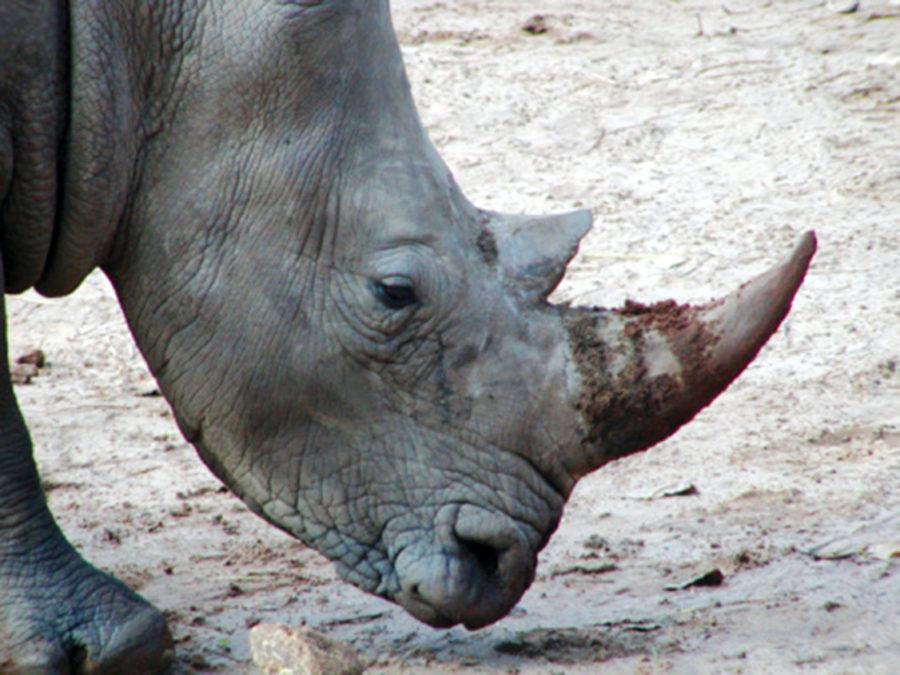Ellingson: Rhino poaching done without regard to facts
The rhinoceros is becoming endangered due to poaching. Poachers sell rhinoceros horns, which are used for medicine and ornaments.
February 25, 2013
If someone told you the horn of a rhinoceros could cure the common hangover or ailment, would you buy the slaughtered animal’s curved horn? You might think that is crazy, but for many poachers in South Africa looking to make a profit, that is all the reason they need to saw off the horn from the body of the rhinoceros, often before the animal is even dead.
Unfortunately, in recent years the poaching of these already-endangered animals has been increasing every year at an alarming rate, especially for the black rhinos and white rhinos in South Africa. In 2007, only 13 were killed. In the year 2008 (the year most of the poaching began), 83 rhinos were killed. While that death toll is higher than it should have been, it is much less than the years that followed. In 2012, 668 creatures were killed for their horns and so far in 2013 at least 102 rhinos have been killed already, and that number continues to grow every day. Since this ordeal began, South Africa has lost more than 1,600 rhinoceroses due to poaching. In Vietnam, the poaching of the Javan rhinoceros resulted in their extinction in 2010.
So why is there such a demand for the horns?
In several Asian countries, there is a rising demand for the rhinoceros horn because it is believed by many to cure sickness as a medicinal substance and has been considered quite valuable in that regard for many centuries. Some ailments it is believed to cure include snake bites, hallucinations, typhoid, headaches, carbuncles, fever, rheumatism, gout, vomiting, food poisoning and even “devil possession.”
For many in Vietnam, the horn is seen as a status symbol for the elite, and it is believed that certain dosages of crushed rhino horn can prevent hangovers and give people a sense of happiness and well-being. There was even rumor of a high-ranking official using rhinoceros horn to cure his cancer.
Others like the color and luster of the horn when carved, especially in the Middle Eastern country of Yemen, where they use carved rhinoceros horns as the handles to daggers that are presented to 12-year-old boys as a coming-of-age tradition. Even farther back, ancient Greeks and Persians thought the horns could purify water and detect poison.
That being said, there is not much scientific evidence to prove the rhinoceros horn actually does any of that, and countries such as China and Yemen have put a ban on the use of them in medicine and material. As for using the horns for medicinal purposes, they primarily consist of keratin, which is what your fingernails are made of, so you might as well chew on your own nails because it would basically have the same effect.
But the maiming and killing of these animals still continues. In South Africa, many rhinoceroses are killed on game reserves that are protected by park rangers, tracker dogs and heavily armed reaction units that cover the ground and sky. The problem is that they have no idea when poachers will strike, and the areas they defend are huge, making it hard to stop all of them. Another issue is that many professional poachers are also equipped with advanced technology and weapons, such as tranquilizers, helicopters, GPS and high-caliber firearms.
The motivation for any poacher is simply this: money and greed. In many areas, the price per gram of rhinoceros horn can be more expensive than gold or cocaine. For a pair of horns weighing 13 pounds, a poacher could easily get $200,000 in Vietnam.
But the killing of a rhinoceros isn’t actually necessary to obtain their horns. If it is cut at least three inches from the base, the horn regrows in about two years and has little effect on the animal. Many people believe that if rhinos regularly had their horns trimmed, it would deter poachers. Others think poachers would take what they can get, whether that’s the entire horn or just the three inches of stump that remain.
In recent years, laws have been passed in many countries that punish poachers with fines and jail time for their crimes, especially since the rhinoceros horn trade is illegal. Many places also have a “shoot on sight” rule, where poachers can be shot and killed without penalty to those defending the rhinos.
Hopefully with the growing attention towards this issue from citizens, non-governmental organizations and political figures, rhinoceros poaching will decrease and they will get off the endangered species list in the future. However, with the way it’s currently going, the rhinoceros could possibly become extinct within a few decades.
——————————————————————————————-
Caitlin Ellingson is a senior in journalism and mass communication and environmental studies from Milo, Iowa.

















